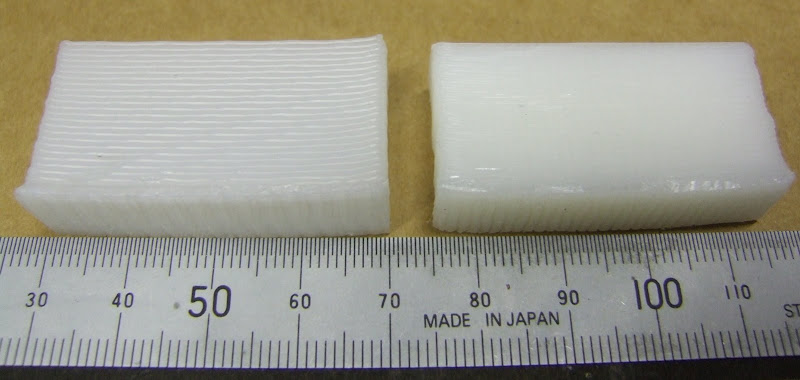
Obviously there are many ways to fill the interior so I started with the simplest, just alternate layers of horizontal and vertical zigzags. HydraRaptor seems quite happy extruding 0.5mm diameter filament at 16 mm / second. If extruded into free air it would actually be 1mm at 4mm/s, but that is too course, so I move the head at 16mm/s which stretches it.
From trial and error I have found that a good layer height to use is 0.8 times the notional filament diameter. If it is more, then as the lower layers shrink, the nozzle rises faster than the object and a gap develops. Once that happens the filament squirms about and does not follow the path of the nozzle accurately.
So the extruded filament is constrained to 0.4mm high. Measurements show the width to be about 0.6mm. Incidentally, if it squashed to a perfect ellipse with a height of 0.4mm then it would be 0.625mm wide to have the same area as a 0.5mm circle. I extrude the zigzag with a pitch of 0.6mm so that adjacent filaments touch, but it means the object is not actually completely solid. The space occupied by each filament is a rectangular channel 0.4 x 0.6 = 0.24mm² but the cross sectional area of the plastic is π x 0.25² = 0.20mm², so about 18% is air. I confirmed this by weighing the block. It weighs 6.5g but if it was solid HDPE then 8ml would weight about 8g. It takes about 45 minutes to make the object including laying a raft.
Before I tried it, I always imagined the amount of plastic deposited would have to exactly match the volume of the extruded object otherwise it would sag or bulge. I could never understand how FDM worked reliably. Now I know that the volume can be a bit less and the difference is made up by air. That means the amount of plastic deposited is actually not that critical, which is why RepRap can get away with an open loop extruder.
I measured the warping with the three nail jig that I showed in the last post. The thin walled box is warped 0.44mm and the solid box has warped 0.87mm so that answers the question whether solid objects warp more or less. Note that the thin walled box is made with 1mm filament because 0.5mm filament is too thin to be self supporting.
I expect I can make a less warped block by extruding a thick base and then a less dense infill above that. Something else to try.
It is amazing how strong 10mm thick HDPE is. You don't often get to see plastics in that form. Most end products have optimised strength against cost by having thin walls and ribs etc.








